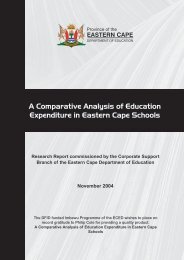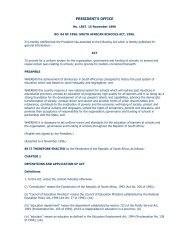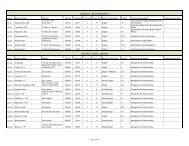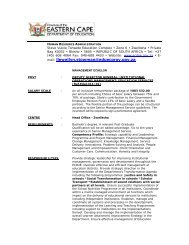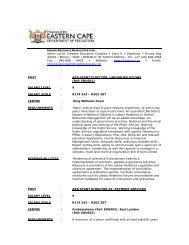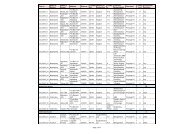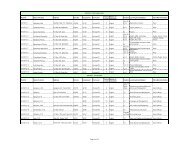part a: strategic overview - Department of Education
part a: strategic overview - Department of Education
part a: strategic overview - Department of Education
Create successful ePaper yourself
Turn your PDF publications into a flip-book with our unique Google optimized e-Paper software.
Total<br />
Population<br />
aged 14-18<br />
GER<br />
Secondary<br />
Phase<br />
Total<br />
Enrolment<br />
(Grades 1 to<br />
12)<br />
Total<br />
Population<br />
aged<br />
17-18<br />
GER Primary<br />
and Sec.<br />
Phases<br />
1996 1997 1998 1999 2000 2001 2002 2004<br />
771 899 784 485 797 276 810 276 823 488 836 915 850 561 892,697<br />
82% 67% 80% 81% 74% 73% 72% 66%<br />
2 406 712 1 927 313 2 274 559 2 323 882 2 146 052 2 093 254 2 062 014 1,966,185<br />
1 966 160 1 984 119 2 002 243 2 020 532 2 038 987 2 057 612 2 076 407 2,150,417<br />
122% 97% 114% 115% 105% 102% 99% 91%<br />
What is also evident from the age-grade matrices is that the problem <strong>of</strong> over- and underage<br />
learners continues throughout the primary school grades, and is compounded by<br />
high repetition rates. In 2002, for example, nearly 20% <strong>of</strong> all learners in primary schools<br />
were either less than age seven or over age 13.<br />
The drop in the primary school GER for 2001 and 2002 to 121% and 118% is a positive<br />
development and indicates a higher percentage <strong>of</strong> appropriately aged pupils in primary<br />
schools. This was driven by a decline in primary phase enrolment between 2000, 2001<br />
and 2002 against only slight population increases for 7-13 year olds during the same<br />
period.<br />
Although there are more children in Grades 1 to 7 than there are 7-13 year olds in the<br />
population (due to over/under age -enrolment), this situation is reversed for secondary<br />
schools. The GER for secondary schools was in the low eighties at 82%, 80% and 81%<br />
for 1996, 1998 and 1999, before dropping and stabilising at 74%, 73% and 72% in 2000,<br />
2001 and 2002.<br />
A GER <strong>of</strong> less than 100% is generally indicative <strong>of</strong> under-enrolment unless large<br />
numbers <strong>of</strong> learners were able to complete the secondary school phase before they<br />
reach age 18, which is unlikely to be a factor in the Eastern Cape.<br />
The GER measures the capacity <strong>of</strong> schools to accommodate the population <strong>of</strong> the<br />
relevant school-going age. It is defined as the proportion <strong>of</strong> learners in a <strong>part</strong>icular grade<br />
or phase, divided by the population <strong>of</strong> the corresponding school-going age and then<br />
expressed as a percentage. The GER includes over-aged and under-aged learners.<br />
13.9.3 Repetition Rate:<br />
The Repetition Rate measures the extent to which learners repeat grades and is<br />
calculated by dividing the number <strong>of</strong> learners who are repeating a specific grade by the<br />
enrolment for that grade in the previous year. High repetition rates give rise to a number<br />
<strong>of</strong> problems, most notable <strong>of</strong> which is increased class sizes. A repetition rate <strong>of</strong> 20% for<br />
a class <strong>of</strong> 48 learners means for example that there are 8 extra learners in the class who<br />
are repeating the grade. Once learners repeat grades more than once, the problem <strong>of</strong><br />
over-aged learners compounds difficulties.<br />
Table 24 shows that the repetition rates for grade 1 to 12 are 12% in 2001, 12,3% in<br />
2002, and 9% in 2003. The repetition rates per grade for the years 2001 to 2003 show a<br />
5 Year ECDoE Strategic Plan for 2005/06 to 2009/10. March 2006 Page 78<br />
5 Year ECDoE Strategic Plan for 2005-06 to 2009-10. 21 F (4)Page 74<br />
<strong>part</strong> C: background information




